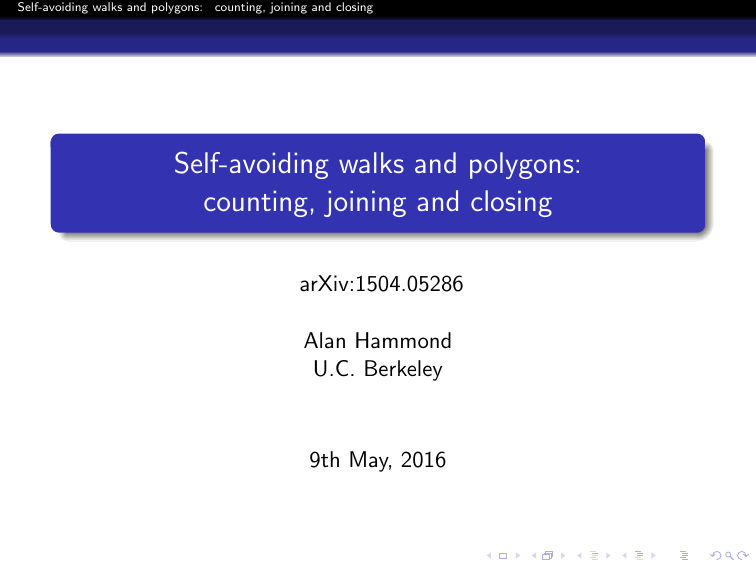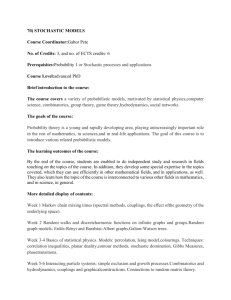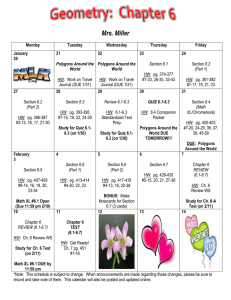Self-avoiding walks and polygons: counting, joining and closing arXiv:1504.05286 Alan Hammond
advertisement

Self-avoiding walks and polygons: counting, joining and closing
Self-avoiding walks and polygons:
counting, joining and closing
arXiv:1504.05286
Alan Hammond
U.C. Berkeley
9th May, 2016
Self-avoiding walks and polygons: counting, joining and closing
Self-avoiding walks
Self-avoiding walk is a fundamental example of a discrete model in
statistical mechanics. It was introduced by Flory and Orr in the
1940s as a model in chemistry of a long chain of molecules.
A self-avoiding walk in Zd of length n is
a map γ : {0, . . . , n} → Zd
that makes nearest-neighbor steps
and visits no vertex twice.
Figure: A planar self-avoiding walk of length twenty.
Self-avoiding walks and polygons: counting, joining and closing
The uniform law on self-avoiding walks
Let SAWn denote the set of self-avoiding walks of length n that
start at the origin.
Let Wn denote the uniform measure on SAWn .
The length n walk under the law Wn will be denoted by Γ.
Self-avoiding walks and polygons: counting, joining and closing
Simulation of planar SAW due to Tom Kennedy
SAW in plane - 1,000,000 steps
Self-avoiding walks and polygons: counting, joining and closing
The endpoint of self-avoiding walk
Define the mean-squared displacement of the endpoint of the walk:
X
1
||γn ||2 .
h||γn ||2 i = |SAW
n|
γ∈SAWn
It is conjectured (and *rigorously known) that
1
d
3/4
d
2 1/2
ν+o(1)
h||γn || i
= n
where ν = ≈ 0.59 d
1/2
d
1/2
d
= 1∗
= 2 Nienhuis 1982
=3
=4
≥ 5∗ Hara, Slade 1992.
Self-avoiding walks and polygons: counting, joining and closing
Closing walks and self-avoiding polygons
A length n walk that ends at a location neighbouring the origin is
said to close.
When such a walk γ closes, it is natural to add in the missing edge
that connects γn and γ0 .
A self-avoiding polygon results.
Figure: A closing walk and its polygon.
Self-avoiding walks and polygons: counting, joining and closing
Counting walks and polygons
Let cn denote the number of length n walks starting at the origin.
Let pn denote the number of length n polygons up to translation.
Then the closing probability satisfies
2(n + 1)pn+1
.
Wn Γ closes =
cn
Self-avoiding walks and polygons: counting, joining and closing
Walk subadditivity
A length n + m walk γ can be severed at the vertex γn .
Two walks, of length n and m, result.
Thus, cn+m ≤ cn cm .
1/n
We may thus define the connective constant µW := limn∈N cn .
Self-avoiding walks and polygons: counting, joining and closing
Polygon superadditivity
A polygon cannot be severed in two in this way.
However, a pair of polygons may be joined so that the new
polygon’s length equals the sum.
Thus, pn+m ≥
1
d−1 pn pm .
1/n
We may thus define µP = limn∈2N pn .
Self-avoiding walks and polygons: counting, joining and closing
Polygon and walk deviation exponents
In fact, the two connective constants, µW and µP , are equal. This
is because of a classic unfolding argument of Hammersley and
Welsh.
Set µ to be the common value.
We have that pn ≤ µn ≤ cn .
Let’s set
pn = n−θn µn
and
c n = n ξ n µn .
Thus, θn and ξn are non-negative real numbers.
Self-avoiding walks and polygons: counting, joining and closing
Hyperscaling relation
It is natural to define the polygon deviation exponent
θ := lim θn
n∈2N
(though it may be very hard to prove that θ exists!)
A well known hyperscaling relation is believed to relate θ and ν:
θ = dν + 1 .
We now present a heuristic derivation of the lower bound
θ ≥ 2ν + 1
in two dimensions.
Self-avoiding walks and polygons: counting, joining and closing
Hyperscaling relation lower bound
We will argue this in three steps:
Step one: θ ≥ ν;
Step two: θ ≥ ν + 1;
Step three: θ ≥ 2ν + 1.
Self-avoiding walks and polygons: counting, joining and closing
Step one
This is Madras’s 1995 polygon joining argument.
Take two polygons of length n.
There are order nν places where the second may be joined on the
right to the first.
Thus,
p2n ≥ nν pn2 ,
and
pn ≤ n−ν µn ,
implying that θ ≥ ν.
Self-avoiding walks and polygons: counting, joining and closing
Step two
How can we progress from here?
We can join polygons in length pairs (n + j, n − j), not just for
j = 0 as before, but for all |j| ≤ n/2.
We would seem to achieve
p2n ≥ n
ν
n/2
X
pn+j pn−j ,
j=−n/2
and thus θ ≥ ν + 1.
However, the joined polygons must have few macroscopic join
points to reach this bound.
But it is plausible that they do typically.
Self-avoiding walks and polygons: counting, joining and closing
Step three
We aim to move from θ ≥ ν + 1 to θ ≥ 2ν + 1.
All of the polygons we’ve been manufacturing are double bubbles.
We now argue that the fraction of length 2n polygons that are
double bubbles is at most Cn−ν .
This provides the extra ν term that we seek.
Self-avoiding walks and polygons: counting, joining and closing
Step three: escape from double bubble
Consider a typical length n polygon.
It crosses the strip − nν , nν × R at least twice.
So there is a highest and a lowest crossing.
Now resample the uniform length n polygon by first sampling this
law, and then forgetting about everything except:
the highest crossing;
and the lowest crossing, up to vertical translation.
Self-avoiding walks and polygons: counting, joining and closing
Step three: escape from double bubble
−nν
nν
Figure: A uniform length n polygon on the left. Then two resamplings.
There’s order nν vertical shifts that the lowermost crossing may
undergo.
Only one of the them – the highest – leads to a double bubble.
So the chance of double bubble is at most Cn−ν .
Self-avoiding walks and polygons: counting, joining and closing
Hyperscaling relation lower bound
So that’s a non-rigorous argument for θ ≥ 2ν + 1.
The derivation provides a useful framework for discussing rigorous
proofs that use polygon joining.
Suppose a rigorous argument follows this three-step approach. Call
it an (a, b, c)-argument, where these entries are the respective
gains in θ made at each step.
So for example Madras’ polygon joining argument is a
(1/2, 0, 0)-argument.
Self-avoiding walks and polygons: counting, joining and closing
The main results
The first result is a new lower bound on θn .
Recall that Madras’ polygon joining shows that θn ≥ 1/2.
Theorem (1: Polygon Joining)
Let dimension d = 2. For a positive density subsequence, θn ≥ 1.
Self-avoiding walks and polygons: counting, joining and closing
The main results
The next result concerns the closing probability Wn Γ closes .
It’s not so obvious even that this quantity tends to zero in high n.
With Duminil-Copin, Glazman and Manolescu, we showed that
Wn Γ closes ≤ n−1/4+o(1) .
Theorem (2: Snake Method via Gaussian Pattern Fluctuation)
Consider any dimension d at least two. Then
Wn Γ closes ≤ n−1/2+o(1) .
Self-avoiding walks and polygons: counting, joining and closing
The main results
It’s clear that this proof technique cannot do better than n−1/2 .
But we can push below n−1/2 by mixing the two techniques –
polygon joining and the snake method.
Theorem (3: Snake Method via Polygon Joining)
Let d = 2. Then, for a positive density subsequence of odd n,
Wn Γ closes ≤ n−6/11+o(1) .
In fact, we may replace 6/11 by 2/3 conditionally inter alia on the
existence of θ.
Self-avoiding walks and polygons: counting, joining and closing
An overview of some aspects of the proofs
Theorem 1 – i.e., θn ≥ 1 on a subsequence – is derived by
endeavouring to rework the three step derivation.
Madras already did step one rigorously – a (1/2, 0, 0)-argument.
To prove Theorem 1, we aim to implement step two – that is, to
give a (1/2, 1, 0)-argument.
But we don’t quite
succeed, and wind up giving a
1/2, 1 − 1/2, 0 -argument.
Self-avoiding walks and polygons: counting, joining and closing
An overview of the proof of Theorem 1
Remember that step two works out – and leads to a gain of one in
the value of θ – if most double bubble polygons have few
macroscopic join points.
In this rigorous version, we show only that there are typically at
most n1/2 such points.
Self-avoiding walks and polygons: counting, joining and closing
An overview of the proof of Theorem 1
Why at most n1/2 join points?
If there are more, then reflected walks may be modified to produce
1/2
more than e n walks matched to each polygon.
But that contradicts the classical Hammersley-Welsh bound.
NE
ES
Figure: A polygon with its join points, then reflected and locally modified.
Self-avoiding walks and polygons: counting, joining and closing
The snake method
To explain something of how Theorem 2 – closing probability is at
most n−1/2 – is obtained, we begin by discussing the snake method
in a general guise.
It’s a proof-by-contradiction technique for proving closing
probability upper bounds.
It involves constructing sequences of laws of self-avoiding walks
conditioned on increasingly severe avoidance constraints.
Self-avoiding walks and polygons: counting, joining and closing
Explaining the snake method
First of all, a reflection argument shows that, for some c > 0,
Wn Γ closes ≤ c .
Figure: A closing walk may be reflected to form a non-closing alternative.
Self-avoiding walks and polygons: counting, joining and closing
Explaining the snake method
How to improve this inference to show that
Wn Γ closes → 0 ?
Consider a typical first part.
Aim to argue that a walk in the half-space from the northeast
corner typically meets the first part.
Figure: The reflection is viable even if the two parts meet on the left.
Self-avoiding walks and polygons: counting, joining and closing
Explaining the snake method: polygonal invariance
To argue that the two half-space walks typically meet, polygonal
invariance is an important tool.
Self-avoiding walks and polygons: counting, joining and closing
Explaining the snake method: Kesten’s pattern theorem
A pattern is any finite piece that may occur in the middle of a walk.
Figure: Type I and II patterns.
A classic result of Kesten asserts the ubiquity of any given pattern.
Theorem
For any pattern P, there exist δ ∈ (0, 1) and c > 0 such that
Wn there are fewer than δn instances of P in Γ ≤ e −cn .
Self-avoiding walks and polygons: counting, joining and closing
Explaining the snake method: Kesten’s pattern theorem
The snake method is a proof-by-contradiction technique.
Suppose that we’re trying simply to show that
Wn Γ closes → 0 .
Suppose instead that the closing probability is at least c.
Call a first part charming if the second part has positive probability
to close the first.
Then for most ℓ ∈ [0, ℓ], most length ℓ first parts are charming.
Self-avoiding walks and polygons: counting, joining and closing
Explaining the snake method: general guise
But as the first part length ℓ rises, the second part length n − ℓ
falls.
If we can show that the first part is often charming even if the
second part length is not changing, then we have a powerful
mechanism for manufacturing alternative walks by reflection.
Self-avoiding walks and polygons: counting, joining and closing
Explaining the snake method: pattern fluctuation
Gaussian pattern fluctuation is a technique for showing that the
second part length may remain fixed as the first part length ℓ
varies.
γ j3
γ j2
Figure: By switching a type I pattern in the first part to be of type II ,
two units of length accumulate in the first part.
γ j1
Self-avoiding walks and polygons: counting, joining and closing
Explaining the snake method: the n−1/2 bound
Type I to type II pattern switching may be maintained for an order
of n1/2 steps without the law Wn noticing much.
This is in essence the same n1/2 as in Theorem 2:
Wn Γ closes ≤ n−1/2+o(1) .
Self-avoiding walks and polygons: counting, joining and closing
Explaining the snake method: beyond n−1/2
How to push below the n−1/2 barrier to reach Theorem 3:
Wn Γ closes ≤ n−6/11+o(1) subsequentially ?
Use the snake method again. Not via pattern fluctuation but via
polygon joining.
Figure: As the first part length falls, deflate the length of the right
polygon in the join. The dotted second part remains of constant length.





